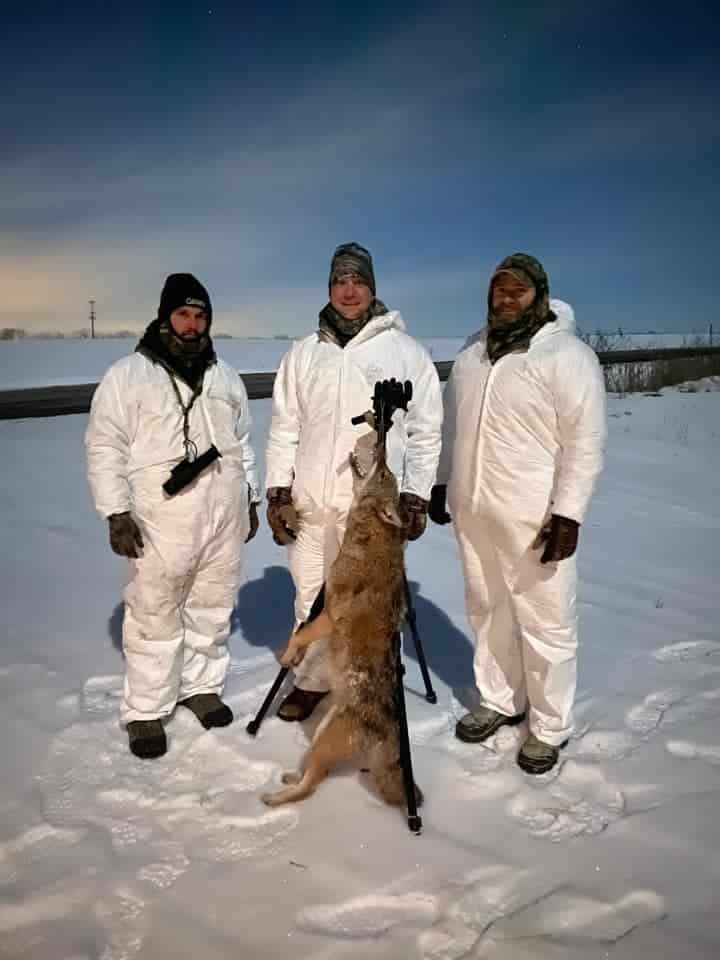Hunting the coyote rut (the coyote mating season) means peak coyote activity, increased reaction to coyote vocalizations, desperate loners in search of mates, and prime fur.
Unfortunately, January and February are also two of the coldest months of the year. Freezing winds, feet of snow, and treacherous ice await the timid predator hunter, quickly sending them retreating to their vehicle.
But for those with backbones stronger than steel rifle barrels, rare prizes like doubles and fully prime, defect-free pelts await.
Hunting the coyote rut.
By January, all of the recently dispersed pups have one goal in mind; finding a territory to call their own. They will begin by traveling to new lands and sizing up many potential landscapes. Some will quickly settle down in rich uninhabited regions.
Others will be less lucky, forced to move considerable distances from their birth dens to find even a modest place to call home. Finally, the unluckiest will blunder into the claimed territory of other coyotes, suffer a few humiliating beatings, and spend the following year as unmated transients.
However, all of them are about to experience a new, greater desire: An intense, undeniable need to breed.
The coyote mating season is a tiny window of time, filled with angry males defending their females and jealous females driving off other potential suitors. In addition, male coyotes engage in real and mock territorial disputes, all designed to increase their attractiveness to the females.
At the foundation of it all? The female coyote only goes into estrus once a year. Therefore, time is limited. Success favors the bold with limited time and an unrelenting natural urge to breed or be bred. The bold, however, often take fatal chances.
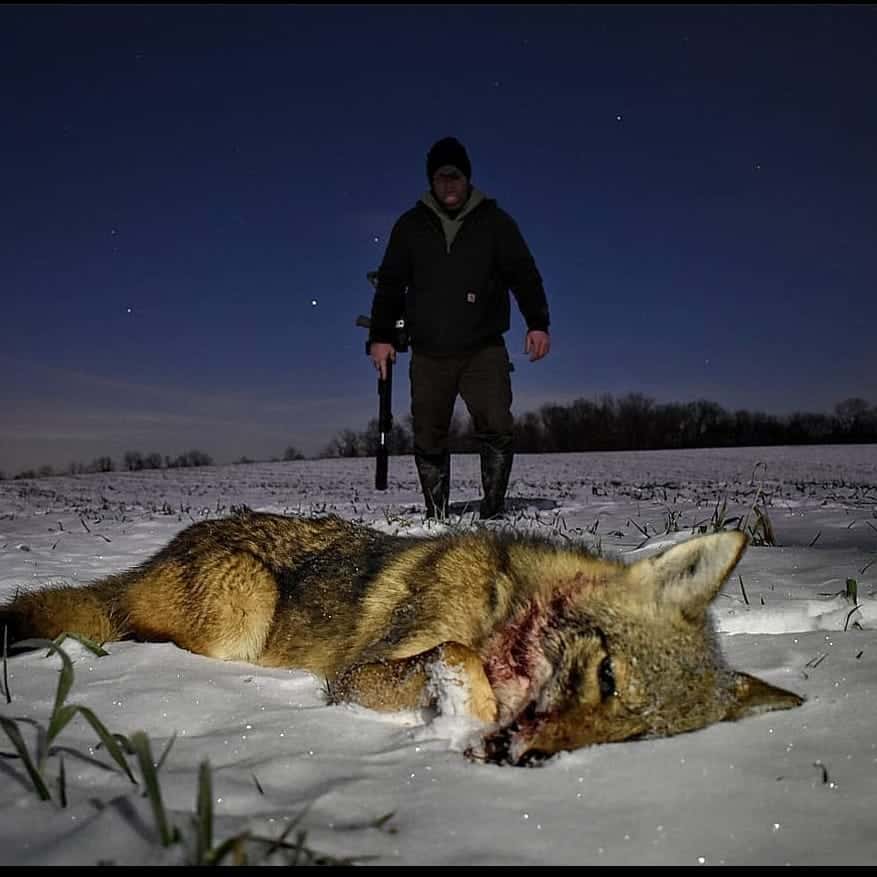
Above: Dan Raddish explains how this coyote met its fate and what calls he likes to use.
“On this set, I used the ole bitch getter scenario.
I started with a lone male howl, followed by female invitation, light breeding whimpers, and coos; all of these on a diaphragm call.
It’s simple but paints a picture the caller and the coyotes understand. As a result, they frequently come in hot. Usually, vocals get me circled for wind, but they’ll often come straight in with this one.”
Related: https://thepredatorhunter.com/keep-them-interested-how-to-really-call-in-coyotes/
Even during coyote mating season, everyone has to feed.
The increase in activity, freezing temperatures, physical demands of moving through the snow, and scarcity of forage during the winter always result in huge demand for meat.
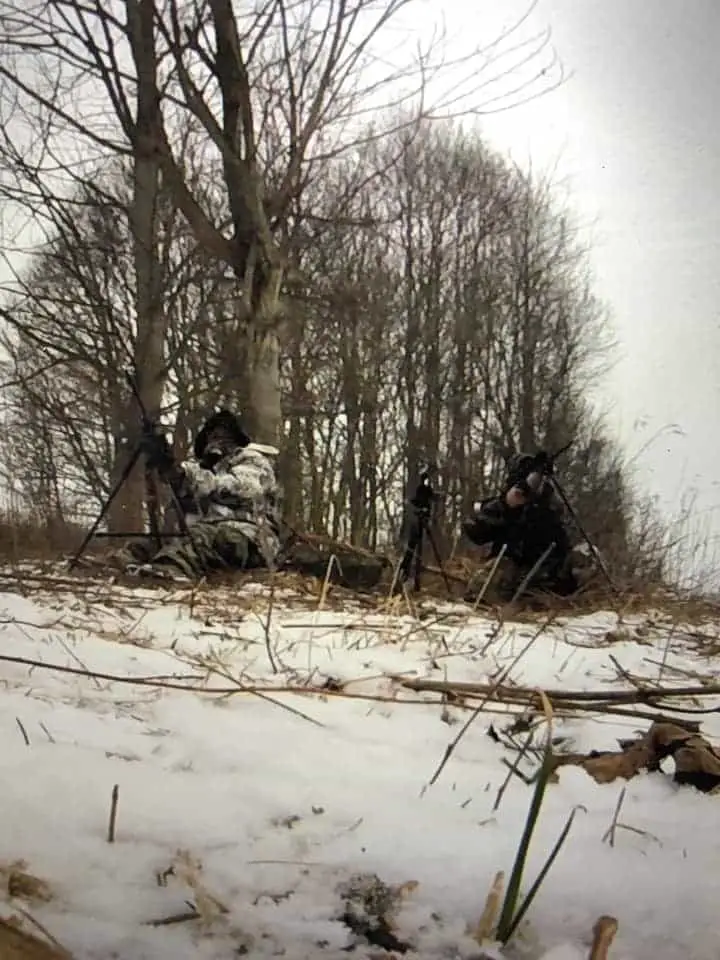
Daylight calling during mating season works best with a decoy. The visual and audible “proof” of an easy meal will be hard, if not impossible, for a hungry coyote to resist. A caller set in bushes that you can shake with some string makes a perfect battery-free decoy for the coyote hunter on a budget.
One of the highest rated (and the only one that hasn’t failed me yet in the field) coyote decoys Amazon has to offer.
Please note: If you use a link I provide to make a purchase, I get a small commission at no extra charge to you. Thanks for your support!
Coyote bait piles are another way to drag even a trespassing resident into shooting range. Bait piles are low-risk meals in a coyote’s eyes. It takes some prep work, but the residents will sit down and claim the frozen treat theirs, night after night, with a bit of luck.
For instructions on how to create the perfect coyote bait pile, read my article: https://thepredatorhunter.com/secrets-of-the-perfect-coyote-bait-pile/.
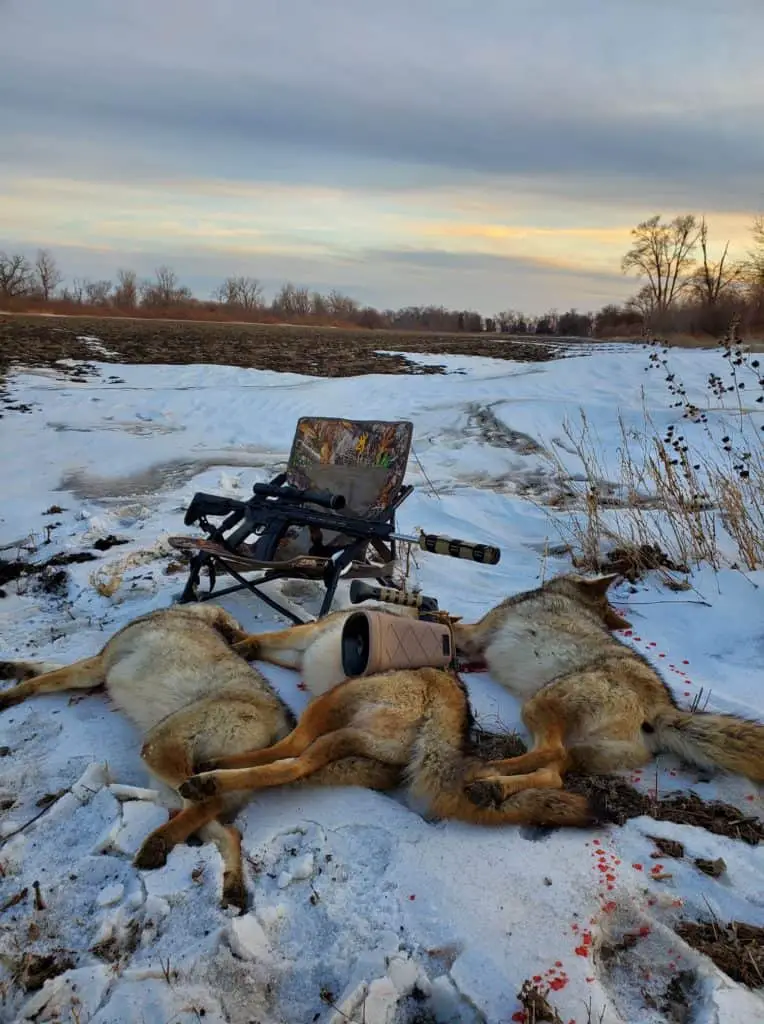
Help them find a home during mating season.
Scouting during the mating season comes with a twist. Regular scouting, finding where the coyotes are now and then, where they think they’ll like to set up a den later.
Regular scouting during coyote mating season.
Regular winter scouting is almost as much about your access as it is to potential food sources for winter coyotes. The rabbit-tat of spring and summer isn’t visible under the snow. However, what will always be visible, day or night, are the coyotes.
This makes scouting for coyotes in the winter a question first of whether or not you can gain access to a potential stand’s location. If you can, you can scout it a few nights before you hunt it.
Grab a red scanning light and caller and wait until just before dark. Now, just like you would on an actual stand, give the area a good 15 minutes to settle down after your arrival. Now make any coyote howl you like and quickly scan the land thoroughly.
If there are any coyotes in the field, they should be looking in your direction, and your light will turn their eyes into little balls of fire. If there are more distant coyotes, you may get a response—especially if a resident coyote objects to your intrusion.
If you don’t spot any eyes or get a return howl, wait 30 minutes and try it again. If you see or hear coyotes, you’ve found a great spot to make your next stand.
If the area is immediately accessible on foot during the day, take a walk and look for some recent coyote signs. Detecting, identifying, and aging coyote sign is a learnable skill. If you need to learn how to do it, here’s my article on it: https://thepredatorhunter.com/coyote-scat-coyote-paw-prints/
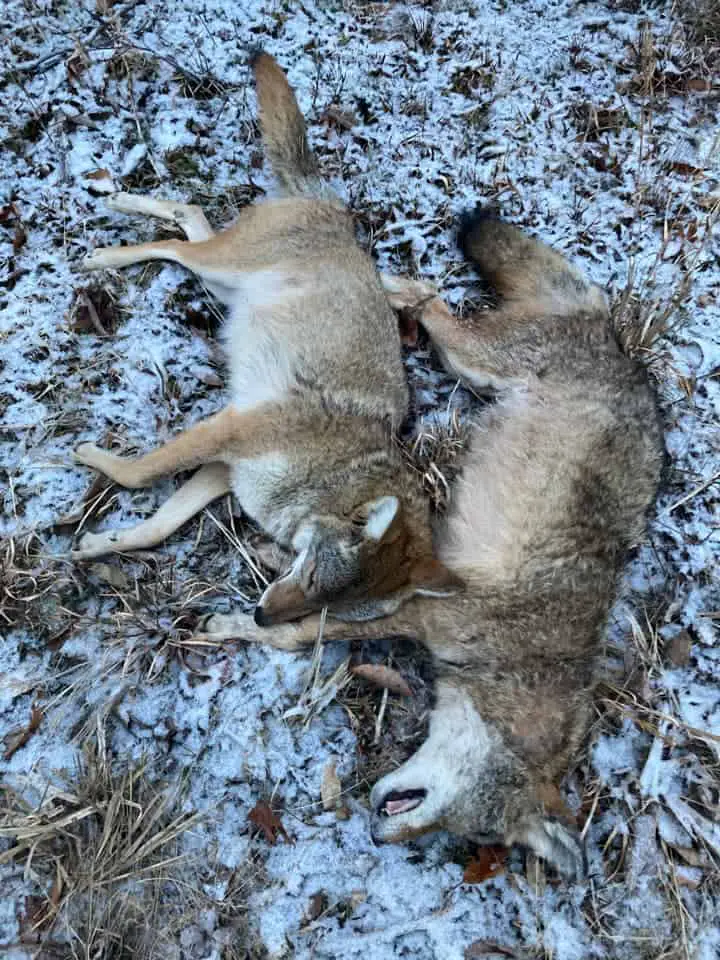
In February, Justin Johns and his buddy Matt McMinn took this male and female while coyote hunting during mating season. Justin said these two had failed to respond to Cagie Cottontail and DSG Cottontail but came running to TT Pup Distress. Justin was the one guy for this article who reported great success using some form of pup distress during the coyote rut.
Den scouting during the coyote rut.
The scouting twist during the rut is identifying areas the coyotes will likely find an attractive den and pup rearing locations.
A good den site for a coyote?
- It’s within 1000 feet of a water source (stream, lake, or pond).
- Built on a hillside or slope provides good drainage and allows the adults to approach from below while scanning for trouble.
- Look for bushes and shrubs above and to the side of the slope. These will provide a concealed spot for the alpha male to rest and watch over the den during the day.
- Bonus: a pre-existing and recently vacated animal borough. Abandoned boroughs have the type of soil that makes for easy excavations and renovations.
Den scouting like this will become much more helpful as the mating season draws to a close.
Need more places to hunt? Start knocking on some doors and get access to private land.
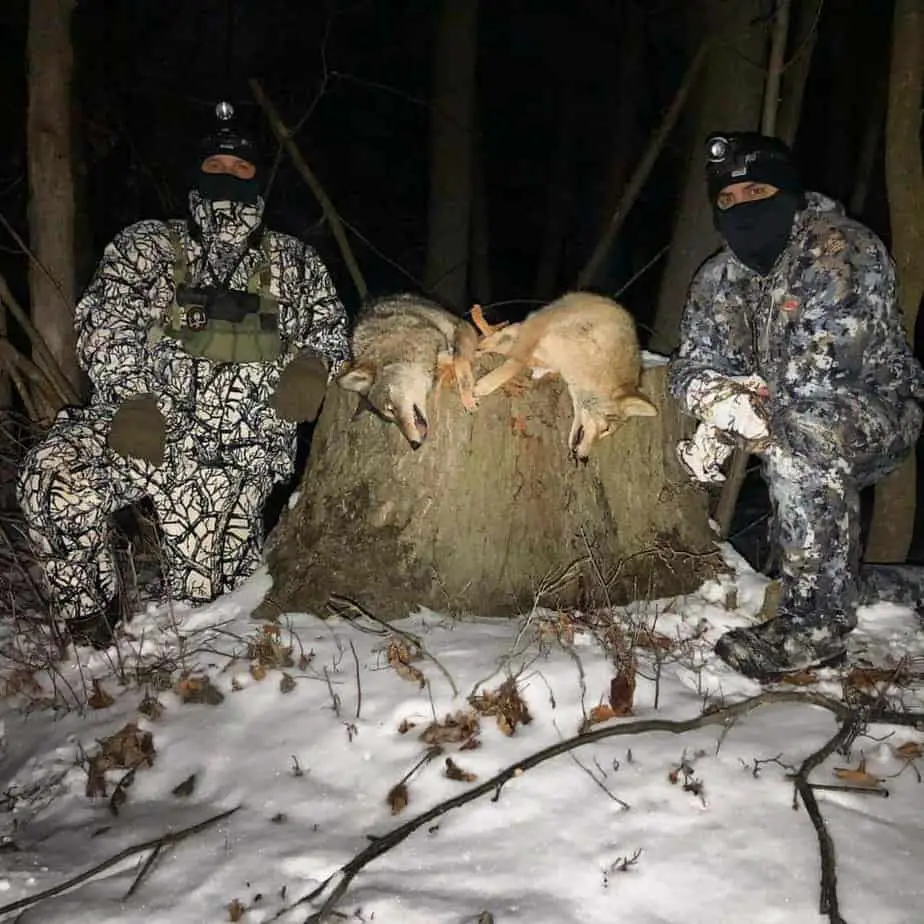
Mike tells me he and Corey have more than 30 years of combined predator hunting experience. The pair solely hunt the Northeast in Western New York.
The picture was of a male and female coyote pair off a bull ranch in WNY. They run a combination of FoxPro and Lucky Duck game calls, both electronic and mouth.
Sit longer, call longer, and be more patient when hunting the coyote rut.
Mating coyotes sometimes other things on their minds. For example, a male tending to a female is waiting for her to stop rejecting his advances and signal she is ready for him. At some point, she’ll start whimpering to signal she is willing to breed, and he wants to make sure he’s the first male dog there.
This concern over their mates can make them resistant to coyote vocalizations and even prey calls. At least for a time. Be prepared to sit a good while longer (even doubling your stand times), call for more extended periods, and exercise a great deal more patience than usual.
During the day, you can have your eyes on a coyote that’s just a bit too far out of range for a long time. However, you’ll have to resist the urge to take a low probability shot and wait your turn.
Looking for the best time of day to hunt eastern coyotes? Read this article: https://thepredatorhunter.com/the-absolute-best-hours-for-hunting-eastern-coyotes/.
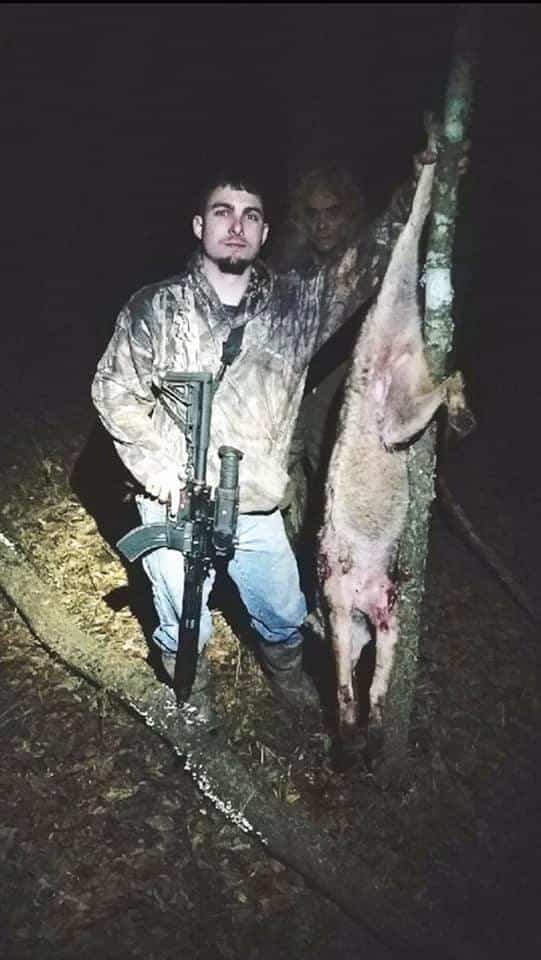
Trey tells us the ghost is actually his neighbor. The two of them hunt about 5 nights a week. They rely of mouth calls most nights, but occasionally switch things up with a FoxPro and some MFK sounds.
Calls to use while hunting the coyote rut.
It should be evident that food and mating are the twin interests of male and female coyotes during mating season. With that in mind, stick to a few particular coyote vocalizations and prey sounds that match what the coyotes expect to hear.
Coyote vocalizations.
Now isn’t the time for pups in distress, but two or three lone howls? That should draw the attention of every male within earshot. These males may try to slip in undetected, so don’t take the lack of a vocal response as proof no one is around.
Males answering lone howls during the mating season often like to come in quietly and scope out the area. You can ease their suspicions by limiting the frequency (and potential aggression implied) of your calls to no more than a few howls every 5 minutes at most.
Female invitational howls and estrus chirps or female whimpers will have the same effect, except they are just as likely to draw in an angry female looking to keep her mate from straying.
When you use sounds that imitate females willing to mate, you really have to extend your stand calling times. That poor transient male who’s having trouble finding a mate and currently trespassing in another dog’s territory, he’s coming in at a snail’s pace.
Target verification is even more critical using these calls, too. The last thing you want to do is take someone’s lovestruck pet. And trust me, domesticated dogs will respond as fast as male coyotes will.
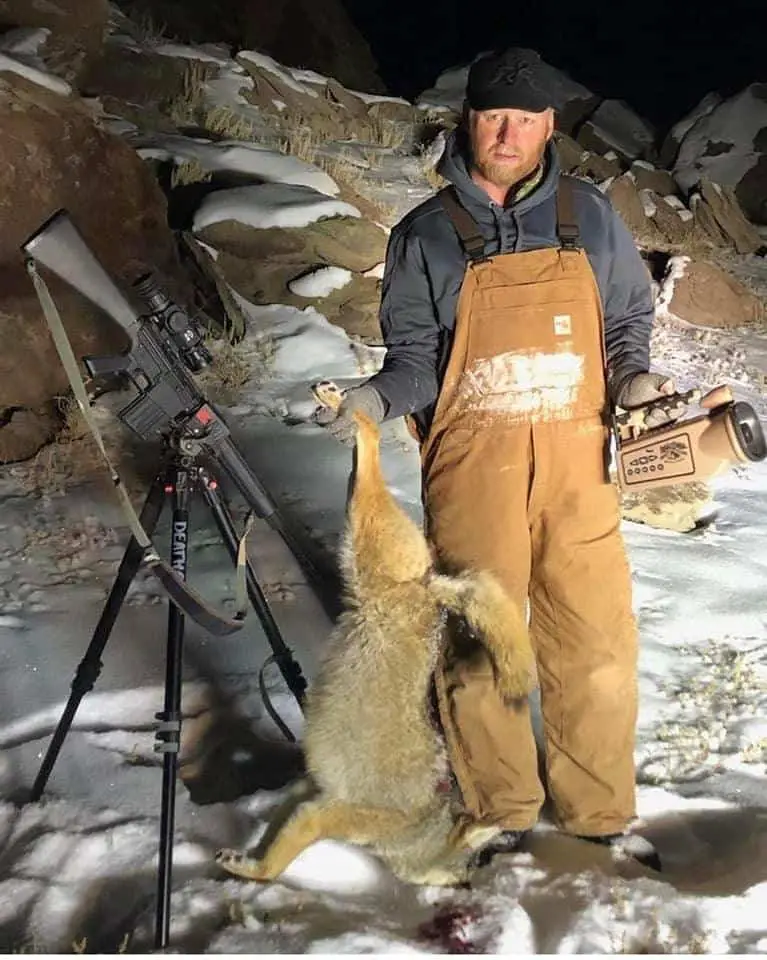
Lance Wilkins prefers to use a lone female howl and young male interrogation during mating season, but he stresses getting in close to them is critical.
Prey sounds.
Well, every coyote hunter seems to love the old rabbit-in-distress. Fortunately, this is the perfect time for it. You can break out your trusted https://www.rushcustomcallers.com rabbit squealer here and hammer away.
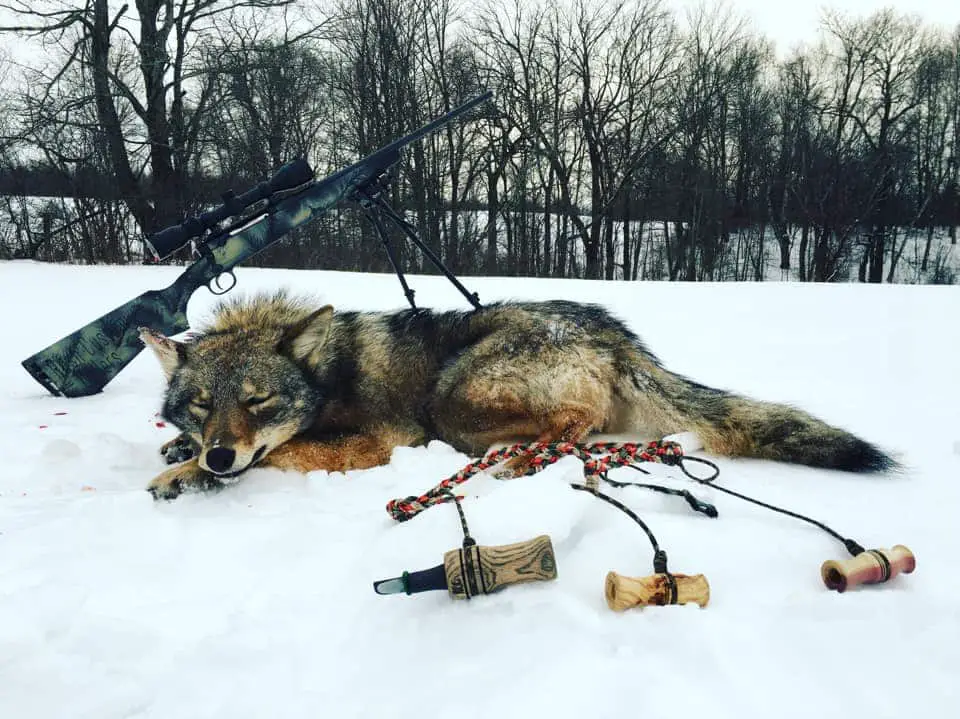
Above: Brian Rush took this female coyote in less than 60 seconds of calling and at 120 yards—all at 3 pm during broad daylight. He used his rabbit squealer to stand her out of her bed in a thicket.
However, pass on that fawn in distress and save the spring and summer calls for their season. Other than that, if the prey animal spends its winter above the snow, have at it.
Not sure how to use a closed reed caller? You are in luck; give this article a peek and let Brian Rush show you how in less than 30 minutes.
Coyote mating season tips from the Master.
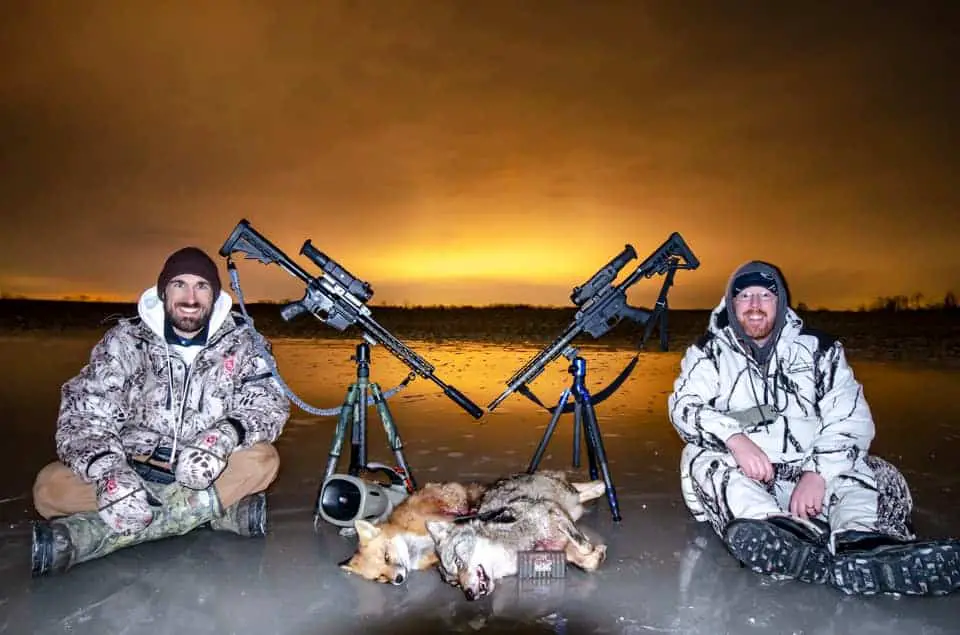
Chris Kreiner is Michigan’s 2020 Predator Caller of the Year. We asked him for a few of his personal favorite mating season calls. As usual, he’s a rule-breaker, disputes everything we recommended above, and still puts more fur in the back of his truck than most predator hunters. Here’s what he had to say.
“As with all my sets, I try to tell a story. So, I usually start my stand with either a male or lone female howl.
I’ll wait 2-4 minutes and add pair howls to the mix. Then, I give it a minute or two and switch to female whimpers.
From there, I move into something more aggressive. I imagine either a male competitor or the female herself is getting upset. So using aggressive female challenge barks and howls allows me to finish the stand with coyote fights. This storytelling often brings any local coyotes in to investigate what is happening.”
Bonus Material: Extra help when hunting the coyote rut.
- When it’s super cold (below zero), coyotes actively conserve energy.
- If the snow is deep, look for coyotes lurking in areas with conifer stands (right where the deer are also likely to be hanging out).
- Snowmobile trails are confirmed coyote highways.
- When the wind is howling, coyotes will find a place to shelter out of it.
- Lower the volume of your first series of calls, then work your way up the dial.
- Hunt before a major snow storm and after the snow had settled and formed a surface hard enough to bear a coyote’s weight.
- Tyvek suits are white, quiet, and can be purchased in sizes large enough to fit over your winter clothing.
- Good shooting sticks will keep your rifle high and out of the snow.
- Mating season is when you finally learn what all the other nonrabbit calls are for. Learn some vocalizations! Here’s three open reed coyote calls you can learn today.
- You do not need night vision to hunt in the moonlight when there is snow on the ground. Give it a try.
- Mated or mating pairs mean doubles. Odds are, the small one is the female. Take her first and hit that KiYi. The male will already be reluctant to leave her behind.
- Even something as simple as a red light mounted on your scope will give you unbelievable night hunting ability on snow-packed land.
- Don’t buy into the “educated coyote” notion if you must hunt public land. Heck, there aren’t that many coyote hunters; fewer still will be out on a freezing February day.
- Once you start to shiver, go home. Your aim will suck, and the longer you suffer, the less likely you’ll ever try it again.
